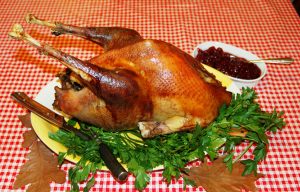Excerpt from Lessons Learned From the Magnificent Bird, by Gary Sefton.
The wild turkey is the essence of turkey flavor. Comparing wild turkey to commercially raised turkeys is like comparing sardines to rainbow trout.
In order to fully appreciate the exquisite flavor, the wild turkey should be ROASTED!
That sounds simple enough, but to fully appreciate the flavor of the wild turkey, the feathers should be removed, leaving the skin intact. You have to ‘pick’ him, and therein lies the rub. For the sake of convenience, or because they just don’t know any better, most turkey hunters just skin the breast, bone it out, then fry it.
Frying alters the flavor of the meat and makes it impossible to tell the difference between wild turkey and domestic. It is also an unceremonious way to treat such a noble bird.

Picking a turkey can be a problem if you don’t know how, especially after you haul one around for three or four hours showing him off. You wouldn’t want to haul him around much longer without cleaning him, especially in warm weather. I’ll tell you how to pick a wild turkey the easy way.
To prepare a turkey for picking, first remove the entrails. his is accomplished by making a T-shaped incision at the lower end of the breastbone, with the leg of the ‘T’ pointing at the turkey’s tail. The foot of the T should terminate at the anal vent.
Then cut around the vent. Reach into the incision, grab a handful of entrails, and pull them out. The first handful, depending on the size of your hand, should contain the gizzard, the liver and the intestines. If you made a good cut around the vent, it will come out with the intestines. Save the liver and gizzard for giblet gravy if you’re so inclined.
The next handful should the heart, lungs and what is loosely referred to as ‘etc. cetera’ if you’re not sure of its function.
Once the body cavity is clean, cut the tail off right next to the body.
Now turn your attention to the other end.
If you have a male turkey, it should have a beard projecting from the chest. You want to save that beard, so cut a section of skin right around the base of the beard and remove the beard. You can grab the beard firmly where it connects and just pull hard. It will come off with minimal flesh, but I’ve always been concerned about the beard falling apart so I take a little skin with it. Beneath the spot where the beard was, you’ll find a thin skin pouch called the craw, or crop, where food is stored prior to digestion. It will appear as a translucent, pink membrane which would be about the size of a small grapefruit filled to capacity, but the craw won’t have much in it during the Spring. This whole pouch needs to be removed because it contains pre-digestive juices that can quickly spoil the meat. When you field dress a turkey ALWAYS remove the craw.
Split the skin from where the feathers start, down to a point about one inch below where the beard used to be. Separate the actual skin from the craw membrane and pull the membrane out. If you’re pulling the right thing, it will have two tubes connected to it, one leading to the body cavity and one leading to the head. Cut the tubes at each end and dispose of the craw.
With that done, cut off the head and wings. I cut the wings off at the first joint from the body since it makes picking easier. Leave the feet on. You’ll need them for handles. The whole operation should take less than five3 minutes.
It’s time to pick. Heat 2-1/2 to three gallons of water to 160-180 degrees F, hot enough that you won’t leave your finger in it very long when you test it, but not hot enough to blister you. You can use a candy thermometer if you want to be precise, and if you do 160 degrees is just right
If you don’t have a container large enough to heat that much water, you can heat several smaller containers to boiling, then temper it with hot tap water until the proper temperature is attained.
Pour the hot water into a large container. I use one of the five-gallon hard plastic buckets that are used to store everything from paint to pickles. It works fine.
Take the turkey be the feet you didn’t cut off and push it down into the hot water. Move it around in the water until all the feathers are thoroughly soaked, which should take about three minutes, lay him on a large table or drape him over a large trash can and remove the feathers with a pulling, rubbing motion. The water is uncomfortably hot, so I wear a pair of Playtex rubber gloves to protect my bare skin.
If some of the feathers won’t come out, dip him again.
When he is picked, he should look like a long-legged version of the turkey you see in the supermarket.
A trace of really fine hair will remain on the skin, which can be removed by singeing with a propane torch or rolled up newspaper.
The bird is now ready to cook. If you start heating the water while you’re doing the preliminary work, you can have a turkey oven-ready in 15 minutes.

